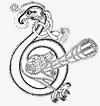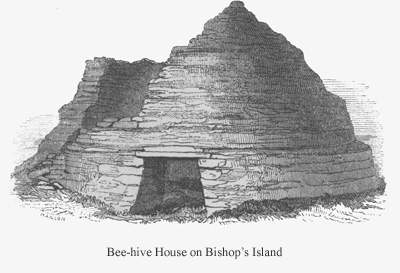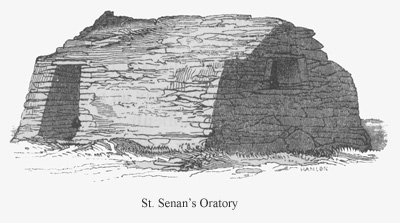Irish Oratories
Examples in Kerry—Their Singular Construction—Bee-hive House—Oratory and Bee-hive House on Bishop's Island—Ruins of St. Fechin's Monastery on High Island
From A Hand-book of Irish Antiquities by William F. Wakeman
« Early Christian Antiquities | Contents | Churches, etc. »
 EFORE we describe the style of church usually found in connexion with our most ancient establishments, it will be well to devote a chapter to those very remarkable oratories, which, though few in number, and remaining only in a confined district of the south-western part of Munster, form among the early structures of Ireland a most interesting and important class. Dr. Petrie, in his work entitled "An Inquiry into the Origin and Uses of the Round Towers of Ireland" has described and engraved the most beautifully constructed and perfectly preserved of those ancient structures now remaining. It stands near Smerwick Harbour, in the county of Kerry, and measures externally forty-three feet in length, by ten in breadth; its height, to the apex of the roof, is sixteen feet. The building is composed altogether of uncemented stones, well fitted to each other, and is roofed by the gradual approximation of the side walls from their base upwards. A square-headed doorway, placed in the centre of the west gable, measures in height five feet seven inches, in breadth at the lintel, one foot nine inches, and at the base two feet four inches. The walls are four feet in thickness at the base.
EFORE we describe the style of church usually found in connexion with our most ancient establishments, it will be well to devote a chapter to those very remarkable oratories, which, though few in number, and remaining only in a confined district of the south-western part of Munster, form among the early structures of Ireland a most interesting and important class. Dr. Petrie, in his work entitled "An Inquiry into the Origin and Uses of the Round Towers of Ireland" has described and engraved the most beautifully constructed and perfectly preserved of those ancient structures now remaining. It stands near Smerwick Harbour, in the county of Kerry, and measures externally forty-three feet in length, by ten in breadth; its height, to the apex of the roof, is sixteen feet. The building is composed altogether of uncemented stones, well fitted to each other, and is roofed by the gradual approximation of the side walls from their base upwards. A square-headed doorway, placed in the centre of the west gable, measures in height five feet seven inches, in breadth at the lintel, one foot nine inches, and at the base two feet four inches. The walls are four feet in thickness at the base.
The eastern gable contains a small semicircularly-headed window, the arch being cut out of two stones. In connexion with the greater number of these remains are to be seen the ruins of small circular structures, which appear to have been the habitations of the ancient ecclesiastics. A fine and hitherto unnoticed example occurs upon the rock called Bishop's Island, near Kilkee, upon the coast of Clare: it measures in circumference 115 feet. The exterior face of the wall, at four different heights, recedes to the depth of about one foot, a peculiarity not found in any other structure of the kind, and which was probably introduced with the view of lessening the weight of the dome-shaped roof, which was formed, not on the principle of the arch, but, as usual, by the gradual approximation of the stones as the wall ascended.
The annexed engraving represents the oratory adjoining, the erection of which is traditionally ascribed to Saint Senan, who lived in the sixth century, and whose chief establishment was upon Inis Cathaigh, or Scattery Island, the Iona of the more southern part of Ireland. It measures eighteen feet by twelve; the walls are in thickness two feet seven inches. The doorway, which occupies an unusual position, in the south side, immediately adjoining the west end wall, is six feet in height, one foot ten inches wide at the top, and two feet four inches at the bottom. The east window splays externally, and in this respect is probably unique in Ireland. Several large monumental pillar stones stand at a short distance from the church, in an easterly direction, but they bear no inscriptions or symbols.
The ancient recluses, or anchorites, appear to have selected the wildest and most dreary spots as their places of abode. Bishop's Island, or as it is styled in Irish, "Oileán-an-Easpoig-gortaigh" i. e. the Island of the hungry or starving Bishop, is a barren precipitous rock, environed with perpendicular or overhanging cliffs, about 250 feet in height. It contains about three-quarters of an acre of surface, to which access is most difficult, and only to be effected by a skilful climber, and after a long continuance of calm weather.
The island of Ard-Oileán, or High Island, off the coast of Connemara, upon which are several of these circular habitations, and a church erected by Saint Fechin in the seventh century, is perhaps equally difficult of access. The ruins are encompassed by a wall or caiseal of uncemented stones, and occupy a position near the centre of the island.
Sheep, which in summer are sent hither from the mainland to graze upon the short sweet grass with which a great portion of the island is covered, and a few martins, are their only occupants. Indeed, such is the lonely and desolate character of the place, that even the very birds appear in some measure to have lost their instinctive dread of intruders; and at the time of our visit, in the summer of 1839, the ground was literally strewn with their eggs, laid upon a few twigs of heath, or upon withered grass or straw, which had been probably picked up from the surface of the sea.


